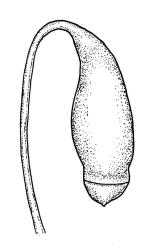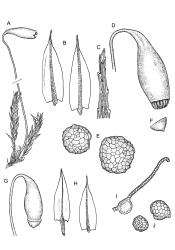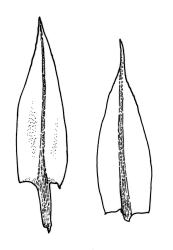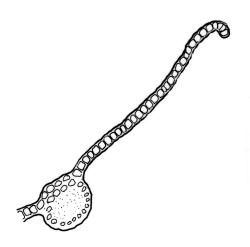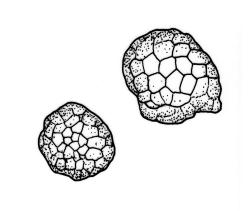- ≡ Gemmabryum radiculosum (Brid.) J.R.Spence & H.P.Ramsay, Phytologia 87: 68 (2005)
Stems to c. 5 mm, beset below with red-brown rhizoids. Leaves evenly spaced on stem, erect-spreading when moist, becoming more erect and narrowed when dry, ovate- or elliptic-lanceolate, acute, entire or weakly denticulate above, very weakly bordered and ± recurved at margins, not decurrent, c. 1.0 × 0.3 mm, with lamina forming c. 0.8–0.9 of entire length; mid laminal cells firm-walled, c. (30–)45 × 8–10 µm; marginal cells elongate in 1–2 rows, forming a weak and ill-defined border. Costa stout and excurrent. Tubers sparse, spherical to oblong, (100–)120–150(–180) µm diam., red-brown, c. 6–8 cells across, cells not protruding.
Dioicous. Perichaetial leaves deltoid, c. 1.5 mm. Perigonia not seen. Setae c. 12–20 mm, red; capsules weakly constricted below the mouth when dry, 1.5–2.5 × c. 1 mm long. Endostome with 2 or 3 appendiculate cilia. Operculum blunt, non-apiculate, glossy, large in relation to the capsule. Spores 9–12 µm.
Crundwell & Nyholm 1964, fig. 1 a–k; Smith 2004, fig. 189, 1–5; Porley 2008, p. 64.
NI: N Auckland (Waipoua, New Lynn, Kaiaua and sterile material from Manukau), S Auckland (Miranda); SI: Otago (sterile material from Benhar and Dunedin). Localities given are for fertile material unless specified.
Apparently bipolar but possibly adventive. Recorded from mainland Australia, Macaronesia, and the Caribbean by Spence & Ramsay (2006) and from additional northern hemisphere localities by Smith (2004).
On mortar and calcareous soils at low elevation; three collections were made from shell fragments close to high tide mark on beaches.
Bryum radiculosum is treated here as one of six N.Z. members of the "B. erythrocarpum complex" sensu Crundwell & Nyholm (1964). The complex is discussed in more detail under B. duriusculum.
The name B. radiculosum Brid. was applied by Linzey to a small number of geographically scattered collections, and accepted by Fife (1995). The species remains poorly documented in N.Z. The occurrence of plants on mortar and calcareous soils is similar to that recorded in other parts of its range by Crundwell & Nyholm (1964). It is distinguished from B. ruderale by tuber and rhizoid colour, and from B. rubens by the non-protruding nature of its tuber cells and narrower, firm-walled laminal cells. B. radiculosum has been found fruiting in N.Z., while B. ruderale has not.
The relatively short, broad capsules and the large, glossy opercula are suggestive of B. coronatum but the present species lacks a swollen capsule neck. Indeed, Crundwell & Nyholm suggest that B. radiculosum "forms a connecting link between B. bicolor (to which B. coronatum is allied, or synonymous) and the other erythrocarpa".



